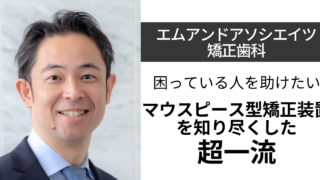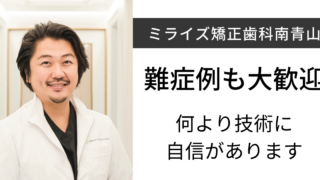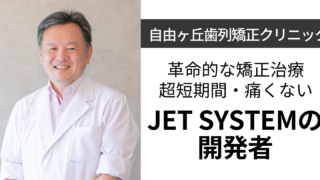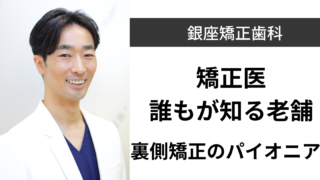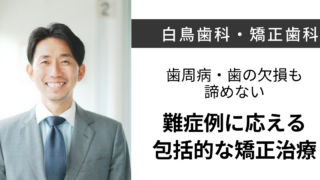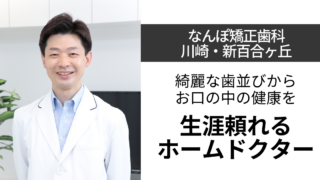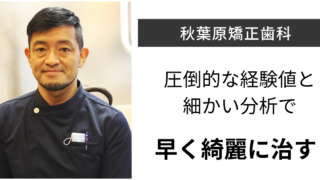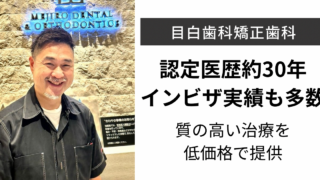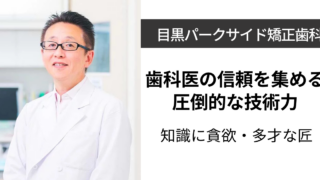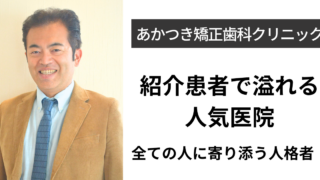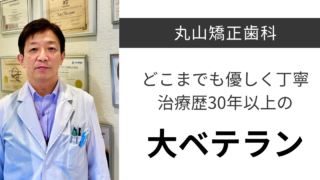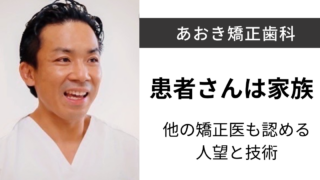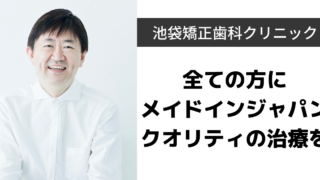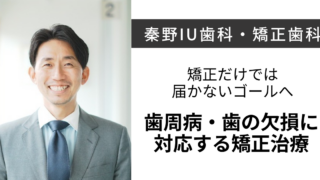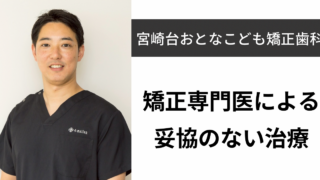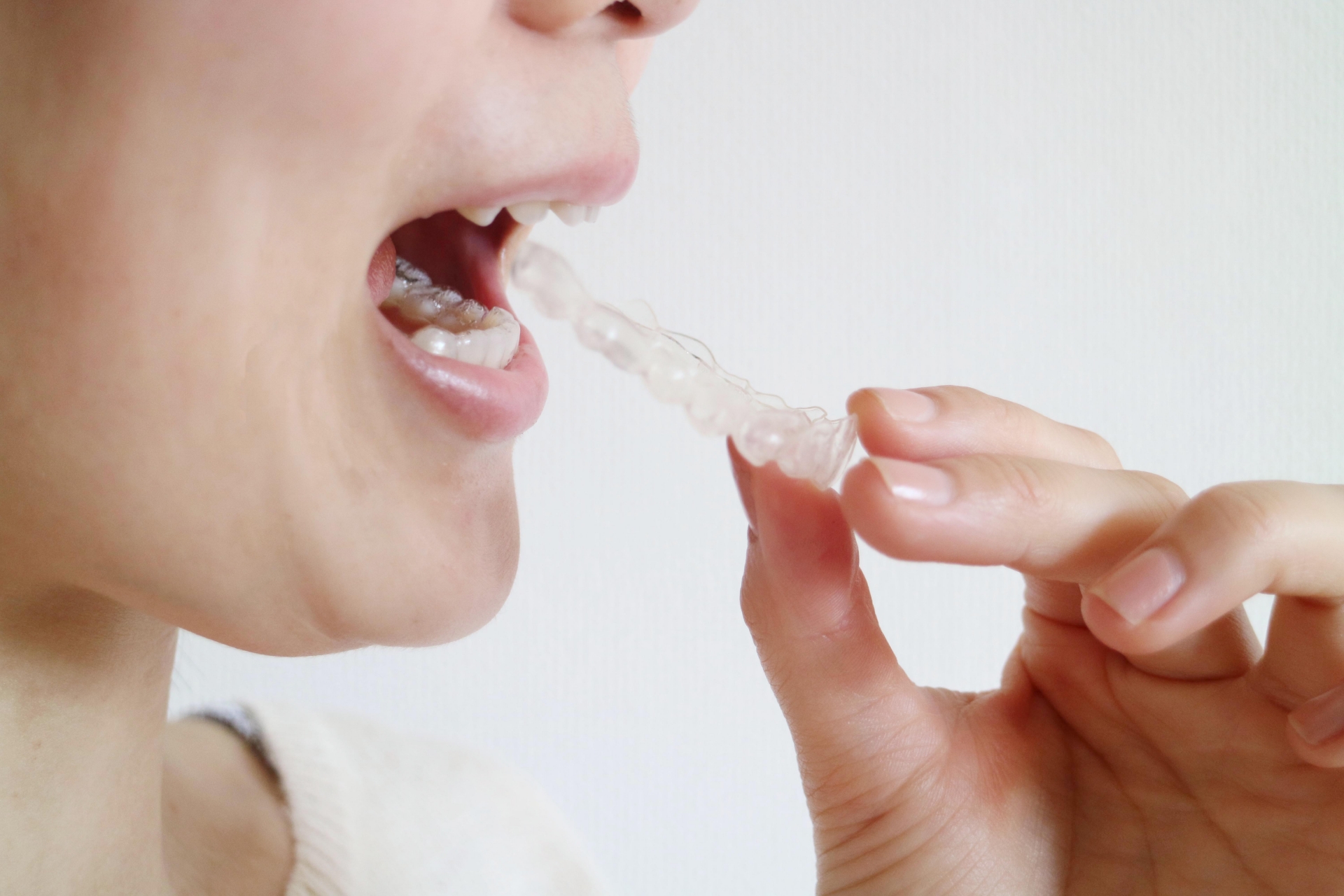
部分矯正ができる人、できない人の違いは何?
部分矯正は治療期間が短くて費用も安いことから、前歯の歯並びだけが気になる方の治療方法として候補に挙げる方も多いことでしょう。
しかし、部分的に歯を動かすため、適用される症例には限りがあります。今回は、部分矯正ができる人とできない人は何が違うのか、部分矯正ができない例を元にご紹介します。
最後に部分矯正セルフチェックもあるので、鏡を見ながら部分矯正ができるかの目安にしてみてくださいね!
部分矯正が難しい例
部分矯正ができるのは、上下それぞれの前歯6本だけを局所的に動かして改善できる症例のみです。
そのため、奥歯を動かす必要のある以下のような症例は、部分矯正ができません。
- 治すのに前歯に3mm以上のスペースが必要な症例
- 八重歯
- 前歯の重なり
- 出っ歯
- 受け口
- 噛み合わせに問題がある症例
- すきっ歯
- 出っ歯
- 受け口
- 開咬
- 過蓋咬合
- 問題が複数ある症例
- 部分矯正で全体矯正と同等の仕上りを求める場合
具体的にどのようなものか、見ていきましょう。
治すのに前歯に3mm以上のスペースが必要な症例
部分矯正では、歯と歯の間を薄く削って歯を並べるスペースを作る「IPR(ディスキング)」を行うことがあります。
IPRは歯に影響がないところまでしか行えないため、歯1本につき作れるスペースは最大0.5mmが限界です。
部分矯正の場合は、上下それぞれ6本が治療対象となるため、0.5mm×6本=3mmが部分矯正で作れるスペースの最大量となります。
そのため、以下の症例で歯を並べるために3mm以上のスペースが必要になる場合は、奥歯の矯正やIPR、抜歯などが必要なので、部分矯正では治せません。
- 八重歯
- 前歯の重なり
- 出っ歯
- 受け口
八重歯
八重歯は前から3番目の歯がほかの歯よりも前に出ていたり、上の方に生えていたりする状態のことです。
八重歯は目立つため、そこだけに注目してしまいがちですが、八重歯になる原因には「出っ歯」「噛み合わせ」「歯の大きさ」などの複数の原因が混在していることがあります。
そのため、八重歯を治すためには奥歯まで動かして3mm以上のスペースを確保しなくてはいけない症例が多く、部分矯正ができないことが多いです。
前歯の重なり
八重歯と同じように、前歯が並ばない原因には、奥歯の噛み合わせや出っ歯などの問題が潜んでいることがあります。
単に前歯が重なって生えているだけで、前歯を並べるために必要なスペースが3mm以下なら部分矯正が可能ですが、重なりが大きい症例や問題が複数ある症例は、部分矯正ができません。
出っ歯
出っ歯は上の歯が前方に向かって斜めに生えていたり、下顎が小さいか上顎が大きいことで、上の歯が顎の骨ごと出ていたりする状態です。
部分矯正が可能かは、原因と出っ歯の程度によって異なります。前歯を後ろに引っ込めるために必要なスペースが3mm以内なら、部分矯正で治療可能です。
ただし、口元を引っ込めたい場合や奥歯の噛み合わせを治す必要がある出っ歯は、抜歯したり顎の骨を切ったりして歯を後ろに引っ張るためのスペースを作る必要が出てくるため、部分矯正はできません。
受け口
受け口は、噛んだときに下の前歯が上の前歯よりも前に出ていたり、上の前歯が下の前歯に被さっていないような状態です。
出っ歯と同じく、部分矯正ができるかは原因と受け口の程度によって異なります。
基本的に前歯に作った3mm以内のスペースで改善できない、中度〜重度の受け口は部分矯正ができません。
噛み合わせに問題がある症例
歯並びの悪さには歯の生え方だけでなく、奥歯の噛み合わせが関係していることが多々あります。以下の歯並びで、噛み合わせに問題がある場合は部分矯正はできません。
- すきっ歯
- 出っ歯
- 受け口
- 開咬
- 過蓋咬合
すきっ歯
すきっ歯は、歯と歯の間に隙間ができている状態です。歯を並べるスペースは十分にありますが、前歯の隙間を閉じたときに、前歯と奥歯の間にスペースが余ってしまうため、部分矯正はできません。
また、噛み合わせの高さが低いことですきっ歯になっている場合や、噛んだときに下の前歯に上の前歯が当たってしまう場合は、噛み合わせを改善しないとすきっ歯が再発したり、下の歯が邪魔ですきっ歯が治らなかったりする可能性があるので、部分矯正は難しいでしょう。
出っ歯
出っ歯は歯が生えている向き、顎の骨の大きさ、噛み合わせの高さなどが原因となって起こります。
単純に歯の生え方に問題があるだけの出っ歯なら部分矯正で改善可能ですが、顎の大きさからくる前後的な噛み合わせの問題や、噛み合わせの高さなどの問題がある出っ歯は、奥歯の矯正が必要になるので部分矯正はできません。
受け口
受け口も出っ歯と同じように、歯の生え方、顎の大きさ、噛み合わせの高さなどが原因で起こります。
顎の大きさや噛み合わせの高さなどが受け口の原因となっている場合は、部分矯正ができません。
開咬
開咬は噛んだときに前歯が噛み合わずに、上下の歯の間に隙間ができる状態です。
本人も気づかないくらいの軽度なものから、前から4番目の歯(第一小臼歯)くらいまで噛まない重度なものまで、状態はさまざまです。
基本的に前歯ではなく奥歯の噛み合わせに原因があるため、部分矯正では治せません。
過蓋咬合
過蓋咬合は、噛んだときに上の前歯が下の前歯に大きく被さっている状態です。
綺麗な歯並びでは、上の前歯が下の前歯を2mmくらい覆っているのが良いとされており、噛んだときに下の前歯が見えなくなるほど深く噛んでいる場合は、重度過蓋咬合とされます。
過蓋咬合は奥歯の高さを改善する必要があるため、部分矯正はできません。
問題が複数ある症例
歯を並べるスペースと噛み合わせの問題に加えて、以下のような問題がある場合は、部分矯正ができません。
- 歯の生え方
- 噛み合わせ
- 正中のズレ
- 舌や唇、頬杖などの癖 など
複数の問題が併発している場合は、抜歯や奥歯の移動などを行う全体矯正や癖の改善が必要です。
部分矯正で全体矯正と同等の仕上りを求める場合
部分矯正では、全体矯正のように大きく歯を並べるスペースを作るための抜歯、顎の骨を切る手術、奥歯の移動などの手段を用いることができず、ごく限られたスペースの中で歯動かす必要があります。
そのため、
- 出っ歯や受け口を治して横顔を綺麗にしたい
- 顎の左右のずれを治したい
といった要望がある場合は、歯の移動量が足りず、仕上がりに満足できないことがあります。
症例にもよりますが、部分矯正で全体矯正と同等の仕上がりを求めることはできません。
部分矯正ができる場合でも、仕上がりに満足できるかをきちんと考慮することが大切です。
部分矯正セルフチェック!あなたはできる?できない?
最終的に部分矯正ができるかは、レントゲンなどを用いた精密検査と歯科医師の診断が必要ですが、歯科医院に行く前に自分でチェックできるポイントを集めました。
タイプ別になっているので、目安として鏡を見ながらチェックしてみましょう。ひとつでも当てはまる場合は、部分矯正ができない可能性があります。
- 八重歯・前歯に重なりがあるタイプ
- すきっ歯タイプ
- 出っ歯タイプ
- 受け口タイプ
- 開咬・過蓋咬合タイプ
八重歯・前歯に重なりがあるタイプ
- 上下の前歯が重なって生えており、内側に引っ込んだ歯が見えにくい
- 歯の側面が見えるくらい、歯が捻れている
- 八重歯がある
すきっ歯タイプ
- 歯と歯の間に隙間がある
- 噛んだときに、下の前歯が上の前歯に覆われて見えなくなる
出っ歯タイプ
- 唇が閉じられない
- 唇を閉じたときに、下顎の先端が梅干のようになって硬くなる
- 口を閉じて顔を横から見たときに、口元が鳥のように突き出た形をしている
- 上顎と比べて下顎がないように見える
受け口タイプ
- 噛んだときに、下の前歯が上の前歯より前に出ている
- 横から見たときに、額・鼻・顎の先端を結んだラインが三日月のようになっている
- 顎がしゃくれている
開咬タイプ
- 噛んだときに、上下の前歯が噛み合わない
- 前から4番目より後ろの歯まで、噛み合わない歯がある
- 噛んだときに、前歯は噛んでいるが奥歯が噛み合わない
過蓋咬合タイプ
- 噛んだときに、下の前歯が上顎に付く
- 噛んだときに、下の前歯が上の前歯に覆われて見えなくなる
その他
- 顔を正面から見たときに、歪んでいる
- 噛み合わせたときや笑ったときに、歯の中心が合わない
部分矯正ができるかできないか相談するなら
部分矯正は歯並びの状態と仕上りを考慮し、歯科医師の診断の下で行う必要があります。
セルフチェックで当てはまる項目があっても、歯科医院に詳しく診てもらうと部分矯正の適応になることもあるので、気になる方はまずは相談してみましょう。
部分矯正ができるか相談するなら、オンラインで歯科医師に相談できる365dentistが便利です。
365dentist総監修 歯科医師/勝屋友紀子
長崎大学歯学部卒業、〜2018 九州医療センター、2018〜現在 都内歯科クリニック勤務
監修 歯科医師/Naomi
臨床研修終後、都内審美歯科勤務。現在は歯科医師/歯科ライター

